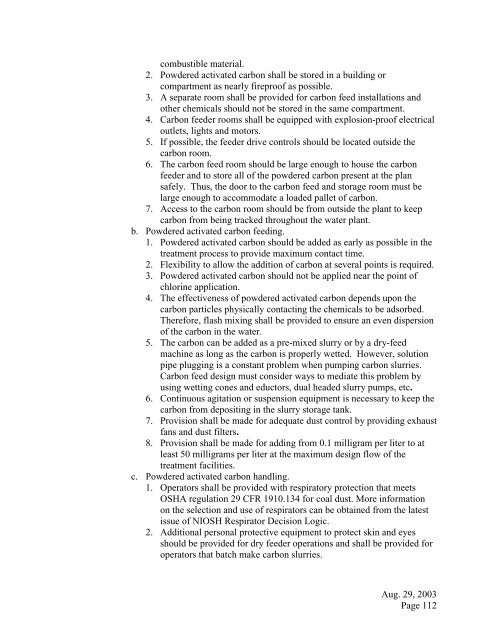Design Guide for Community Water Systems - The Water, Sanitation ...
Design Guide for Community Water Systems - The Water, Sanitation ...
Design Guide for Community Water Systems - The Water, Sanitation ...
You also want an ePaper? Increase the reach of your titles
YUMPU automatically turns print PDFs into web optimized ePapers that Google loves.
combustible material.2. Powdered activated carbon shall be stored in a building orcompartment as nearly fireproof as possible.3. A separate room shall be provided <strong>for</strong> carbon feed installations andother chemicals should not be stored in the same compartment.4. Carbon feeder rooms shall be equipped with explosion-proof electricaloutlets, lights and motors.5. If possible, the feeder drive controls should be located outside thecarbon room.6. <strong>The</strong> carbon feed room should be large enough to house the carbonfeeder and to store all of the powdered carbon present at the plansafely. Thus, the door to the carbon feed and storage room must belarge enough to accommodate a loaded pallet of carbon.7. Access to the carbon room should be from outside the plant to keepcarbon from being tracked throughout the water plant.b. Powdered activated carbon feeding.1. Powdered activated carbon should be added as early as possible in thetreatment process to provide maximum contact time.2. Flexibility to allow the addition of carbon at several points is required.3. Powdered activated carbon should not be applied near the point ofchlorine application.4. <strong>The</strong> effectiveness of powdered activated carbon depends upon thecarbon particles physically contacting the chemicals to be adsorbed.<strong>The</strong>re<strong>for</strong>e, flash mixing shall be provided to ensure an even dispersionof the carbon in the water.5. <strong>The</strong> carbon can be added as a pre-mixed slurry or by a dry-feedmachine as long as the carbon is properly wetted. However, solutionpipe plugging is a constant problem when pumping carbon slurries.Carbon feed design must consider ways to mediate this problem byusing wetting cones and eductors, dual headed slurry pumps, etc.6. Continuous agitation or suspension equipment is necessary to keep thecarbon from depositing in the slurry storage tank.7. Provision shall be made <strong>for</strong> adequate dust control by providing exhaustfans and dust filters.8. Provision shall be made <strong>for</strong> adding from 0.1 milligram per liter to atleast 50 milligrams per liter at the maximum design flow of thetreatment facilities.c. Powdered activated carbon handling.1. Operators shall be provided with respiratory protection that meetsOSHA regulation 29 CFR 1910.134 <strong>for</strong> coal dust. More in<strong>for</strong>mationon the selection and use of respirators can be obtained from the latestissue of NIOSH Respirator Decision Logic.2. Additional personal protective equipment to protect skin and eyesshould be provided <strong>for</strong> dry feeder operations and shall be provided <strong>for</strong>operators that batch make carbon slurries.Aug. 29, 2003Page 112
















